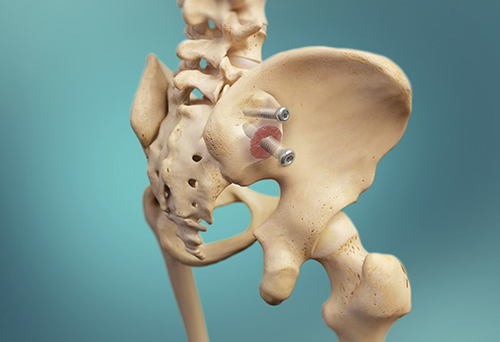
SImmetry Sacroiliac Joint Fusion System design enables true fusion for lasting relief of low back pain. (Credit: PRNewsFoto/Zyga Technology, Inc.)
Zyga Technology, Inc., a medical device company focused on the design, development and commercialization of minimally invasive devices to treat underserved conditions of the lumbar spine, today released 12-month fusion and clinical results for patients receiving SImmetry® Sacroiliac (SI) Joint Fusion with decortication. Study results were presented on Saturday morning at the 2016 Society for Minimally Invasive Spine Surgery (SMISS) Annual Meeting by Dr. William Cross, an orthopedic trauma surgeon at the Mayo Clinic in Rochester, Minn.
“Minimally Invasive SI joint fusion has been established as an effective treatment for certain patients suffering from SI joint disorders, but many technologies available today don’t follow the accepted orthopedic principles that lead to successful long-term fusion,” said Dr. Cross, the lead author and presenter at the SMISS scientific meeting. “For me, it’s common sense that SI joint fusion should include decortication and bone grafting to achieve long-term success. The results of this study provide compelling evidence that decortication and bone grafting may contribute to earlier fusion, and that the procedure provides significant pain relief at one year post-op.”
This prospective, multi-center study enrolled 19 patients at three institutions, who underwent a CT scan 12 and 24 months after receiving minimally invasive SI joint fusion with decortication and bone grafting. CT images were reviewed by a non-biased, independent radiology core laboratory to assess fusion in relation to the joint and the area of decortication. At 12 months, fusion was reported in 74% of patients, and back pain decreased from 7.9 to 2.2 (72%). Of patients in whom fusion was reported, 86% showed fusion in the area of decortication. Freedom from device- or procedure-related adverse events through 12 months was 100%. 24-month results for the study are expected in early 2017.
The SImmetry Sacroiliac Joint Fusion System is a minimally invasive procedure intended for conditions including sacroiliac joint disruptions and degenerative sacroiliitis. The Company will next exhibit at the 2016 North American Spine Society (NASS) meeting inBoston, Mass., October 26 – 28.
The Centers for Disease Control and Prevention lists back problems as the second most common cause of disability in U.S. adultsi. It has been reported that approximately 20 percent of all chronic low back pain derives from the sacroiliac joint.




